Use This Post-Workout Recovery Plan To Come Back Stronger
However tough your training, without the right recovery plan you can only go so far. Here’s how to come back stronger after every workout
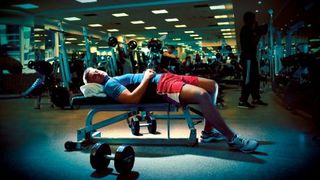
Active Recovery Workout
It’s essential to take days off between workouts to let your muscles grow back stronger – but that doesn’t mean simply burrowing a groove in the sofa. What you need is an active recovery workout.
The science
A good active recovery workout is a not-too-demanding session that drives blood into stiff muscles, as well as loosening them up. Studies have shown that, when performed later on the same day as a more serious workout, these assist with circulation and remove blood lactate, which can reduce muscle soreness. There’s also evidence – from a study done on Japanese rugby players – that low-intensity exercise in the days following an intense bout of exercise can have psychological benefits by enhancing relaxation.
The prescription
An active recovery workout shouldn’t be hard. “These are low-volume, low-intensity workouts,” says personal trainer Tom Davenport. “They should be fun and free-form, instead of serious and goal-oriented.” This might mean a gentle 45-minute bike ride or a friendly kickabout in the park. Alternatively, do a quick circuit of bodyweight moves such as squats, press-ups and lunges – but leave plenty in the tank. “You should finish feeling more energised than when you started,” says Davenport. “Otherwise it’s too hard.”
Self Massage
Just stretching isn’t enough to break up all the knots and scar tissue that accumulate from training. You need to break them up using massage techniques, which will enhance your range of motion as well as reduce soreness and improve your tissue quality.
The science
Clair Davies, author of The Trigger Point Therapy Workbook, defines a trigger point as “a highly irritable localised spot of tenderness in a nodule in a taut band of muscle tissue”. They’re formed when you overstimulate your muscle fibres so they’re unable to be released from their contracted state. This won’t always hurt directly, but even registering the pain subconsciously can cause you to limit yourself. A bit of localised massage will break up these sore spots.
The prescription
You’ve probably seen foam rollers – those pastel-shaded cylinders that look a bit like loft insulation – lying neglected in the corners of your gym. It’s time to start using them. The routine below will hit the areas that most commonly get knotted but if you find some particularly stubborn areas, you can take things up a notch by using a tennis or lacrosse ball to focus on problem areas.
IT bands

Start just below your hip and roll up and down your mid-thigh ten to 15 times, focusing on any tight spots. Then do another 15 rolls all the way down to the outside of your knee.
Get the Coach Newsletter
Sign up for workout ideas, training advice, reviews of the latest gear and more.
Adductors

Lie face down with the roller across your inner thigh. Start just below your hip crease and roll to your mid-thigh for ten to 15 reps. Next, do ten to 15 rolls all the way down to the inside of your knee.
Hamstrings
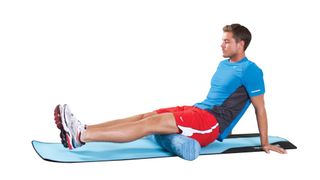
Balance on your hands with your hamstrings resting on the roller, then roll from the base of your glutes to your knees. To hit trouble spots harder, stack one leg on top of the other. Do ten reps with your feet turned in, then another ten with them turned out.
Thoracic spine
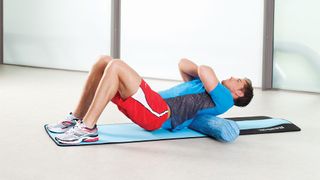
With your arms crossed over your chest, lie with the roller under your mid-back. Roll from the bottom of your shoulder blades to the top of your pelvis, leaning slightly to one side. Repeat on the other side for a total of ten rolls on each side.
See related
- How To Use A Foam Roller: Self-Myofascial Release Explained
- The Best Foam Rollers
- Essential Foam Rolling Exercises For Runners
Stretching
Most people stretch with exercises they’ve seen other people do at the gym. Often they do them for a while, don’t see any benefits and give up. But just a few key moves can make a huge difference to your workouts.
The science
The jury’s out on the benefits of pre-workout stretching. Some studies suggest it’ll weaken you before your main lifts, but these were typically done on subjects who stretched each muscle for longer than 30 seconds for more than one set – no study has ever shown a decrease in strength correlated with a quick 15-second stretch. But there’s no doubt that stretching post-workout, or just before bed or while watching TV, can drastically improve your flexibility, performance and joint health.
The key is picking the right stretches. “Most people focus on hamstring stretches,” says Davenport. “But if you’re doing that and still suffering from tight hamstrings, then it’s possible your problem is actually is in the flexibility of your hips – your glutes, hip rotators, hip flexors and adductors. Tight hip musculature can pull on the pelvis, making it ‘tilt’ and pull on your hamstrings, which makes them tight and increase the chances of a tear.”
The other problem area for most men is the shoulders – the combination of hunching over a desk all day and bench press-centric workouts leaves them unhealthy and injury-prone.
The prescription
For most sport or fitness goals a few basic stretches, done once a day, are all you need. The routine below should take less than ten minutes and is designed to hit the trouble spots affected by regular workouts.
Shoulder capsule stretch
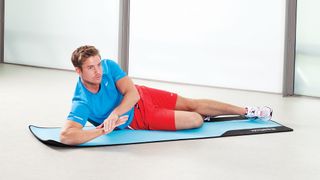
Lie on your side with your upper arm held roughly 45° from your body. Use your upper hand to gently push down on your lower hand and hold for 30 seconds. Aim to get your hand closer to the ground over the course of several sessions but don’t rush it.
Hip flexor stretch
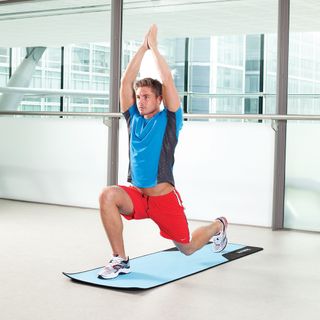
Step forwards as if you’re doing a lunge, brushing your trailing knee against the floor. Push your hips forwards and raise your arms above your head until you can feel a stretch in your hips. Hold for ten seconds. Repeat twice on each side.
Shoulder dislocate
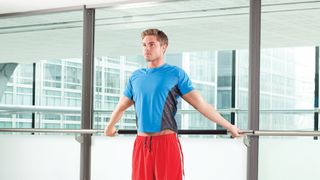
Grab a stretch band or pole – not an empty barbell, they’re too heavy – and lift it overhead, then backwards, “rolling” your shoulders to bring it behind your back. Complete ten reps. Try to bring your hands closer together as your flexibility improves.
Sleep
Sleeping properly is an essential part of peak performance, but most people still fall short of the right amount of shut-eye. Don’t worry – even if you haven’t got time for long lie-ins, you can still recover faster by maximising the quality of your sleep.
The science
“If the brain’s not operating properly thanks to lack of sleep, you start to lose the edge on performance,” says sleep expert Dr Chris Idzikowski. “If the brain isn’t functioning it can have trouble perceiving how much effort the body can put out and will limit itself.” In other words, you won’t be able to run as fast or lift as much as usual.
“There’s also the biological clock effect,” says Idzikowski. “Your body’s primed to be most effective in terms of joint flexibility and muscle efficiency at certain times of the day, and disrupting sleep patterns can play havoc with this. It’s very easy to dislodge the biological clock at the weekends.”
The prescription
You need to maximise your quality of sleep, so avoid late-night snacking and turn down the thermostat, says Idzikowski. “Your body temperature normally hits a minimum around 4am,” he explains. “But if it doesn’t go down at this time the body tends to wake itself up to find out why not. Aim to go to bed warm but in a cool room.”
And keep the lights off. “The release of melatonin, the hormone that helps regulate sleep, is suppressed by light,” says Idzikowski. “So blackout curtains will help you to sleep better.”
Photography: Danny Bird
From 2008 to 2018, Joel worked for Men's Fitness, which predated, and then shared a website with, Coach. Though he spent years running the hills of Bath, he’s since ditched his trainers for a succession of Converse high-tops, since they’re better suited to his love of pulling vans, lifting cars, and hefting logs in a succession of strongman competitions.

